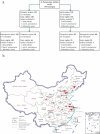Serotype distribution and clinical characteristics associated with streptococcus pneumoniae among Chinese children and adults with invasive pneumococcal disease: a multicenter observational study
- PMID: 32530720
- PMCID: PMC7872053
- DOI: 10.1080/21645515.2020.1757996
Serotype distribution and clinical characteristics associated with streptococcus pneumoniae among Chinese children and adults with invasive pneumococcal disease: a multicenter observational study
Abstract
Few studies in China focused on serotypes of Streptococcus pneumoniae in patients with invasive pneumococcal disease (IPD). We aimed at investigating the serotype distribution for IPD-causing S. pneumoniae and vaccine coverage among Chinese children and adults. This was a multicenter, observational study to collect S. pneumoniae isolates from normal sterile sites and IPD-related clinical information among children and adults. Serotyping was performed by a Capsule-Quellung reaction test using type-specific antisera. The study collected a total of 300 eligible isolates (pediatric = 148, adult = 152) were serotyped in a central laboratory. The most prevalent serotypes were 19A (20.9%) and 23 F (20.3%) in the pediatric group; 3 (21.7%) and 19 F (11.8%) in the adult group. PCV10 had low-to-moderate serotype coverage rates for children (60.8%) and adults (34.2%). PCV13 and PPV23 had high coverage rates for children (89.9%, 93.2%) and adults (70.4%, 82.9%), respectively, Investigational PCVs including PCV15 and PCV20 had high estimated coverage rates in children (89.9%, 93.9%). The study identified 269 subjects with IPD reported as the primary diagnosis in the medical records. Sepsis (48/136, 35.3%) and pneumonia (48/133, 36.1%) had the highest occurrence in the pediatric and adult groups, respectively. Study findings showed that non-PCV7 S. pneumoniae 19A and 3 were the most prevalent serotypes in Chinese children and adults, respectively. High-valent vaccines had similar coverage rates and may have a greater potential in preventing IPD.
Keywords: Streptococcus pneumoniae; in vitro susceptibility; invasive pneumococcal disease; pneumococcal conjugate vaccine; serotype.
Figures



Similar articles
-
Serotype distribution of Streptococcus pneumoniae isolated from children hospitalized in Beijing children's hospital (2013-2019).Vaccine. 2020 Nov 17;38(49):7858-7864. doi: 10.1016/j.vaccine.2020.10.005. Epub 2020 Oct 21. Vaccine. 2020. PMID: 33164807
-
Impact of pneumococcal conjugate vaccines on burden of invasive pneumococcal disease and serotype distribution of Streptococcus pneumoniae isolates: an overview from Kuwait.Vaccine. 2012 Dec 31;30 Suppl 6:G37-40. doi: 10.1016/j.vaccine.2012.10.061. Vaccine. 2012. PMID: 23228356
-
Distribution of Serotypes Causing Invasive Pneumococcal Disease in Children From High-Income Countries and the Impact of Pediatric Pneumococcal Vaccination.Clin Infect Dis. 2023 Feb 8;76(3):e1062-e1070. doi: 10.1093/cid/ciac475. Clin Infect Dis. 2023. PMID: 35789262 Free PMC article.
-
Pneumococcal serotype evolution in Western Europe.BMC Infect Dis. 2015 Oct 14;15:419. doi: 10.1186/s12879-015-1147-x. BMC Infect Dis. 2015. PMID: 26468008 Free PMC article. Review.
-
A systematic review of invasive pneumococcal disease vaccine failures and breakthrough with higher-valency pneumococcal conjugate vaccines in children.Expert Rev Vaccines. 2022 Feb;21(2):201-214. doi: 10.1080/14760584.2022.2012455. Epub 2022 Feb 3. Expert Rev Vaccines. 2022. PMID: 34882050
Cited by
-
Baseline Pneumococcal IgG Levels and Response to 23-Valent Pneumococcal Polysaccharide Vaccine among Adults from Beijing, China.Vaccines (Basel). 2023 Nov 29;11(12):1780. doi: 10.3390/vaccines11121780. Vaccines (Basel). 2023. PMID: 38140184 Free PMC article.
-
Cost-effectiveness analysis of domestic 13-valent pneumococcal conjugate vaccine for children under 5 years of age in mainland China.Hum Vaccin Immunother. 2021 Jul 3;17(7):2241-2248. doi: 10.1080/21645515.2020.1870396. Epub 2021 Feb 12. Hum Vaccin Immunother. 2021. PMID: 33577390 Free PMC article.
-
Global distribution and characteristics of pneumococcal serotypes in adults.Hum Vaccin Immunother. 2025 Dec;21(1):2469424. doi: 10.1080/21645515.2025.2469424. Epub 2025 Feb 27. Hum Vaccin Immunother. 2025. PMID: 40015240 Free PMC article. Review.
-
Genotypic and phenotypic characteristics of Streptococcus pneumoniae from community-acquired pneumonia patients and healthy asymptomatic participants in Sichuan province, China.BMC Infect Dis. 2021 Oct 1;21(1):1030. doi: 10.1186/s12879-021-06737-w. BMC Infect Dis. 2021. PMID: 34598707 Free PMC article.
-
Serotype distribution of invasive and non-invasive pneumococcal disease in adults ≥65 years of age following the introduction of 10- and 13-valent pneumococcal conjugate vaccines in infant national immunization programs: a systematic literature review.Front Public Health. 2025 May 30;13:1544331. doi: 10.3389/fpubh.2025.1544331. eCollection 2025. Front Public Health. 2025. PMID: 40520289 Free PMC article.
References
-
- Pneumococcal vaccines WHO position paper. 2012. [accessed 2017 October]. (http://www.who.int/wer/2012/wer8714.pdf?ua=1 - PubMed
-
- Estimated Hib and pneumococcal deaths for children under 5 years of age. 2008.[accessed 2017 October]. (http://www.who.int/immunization_monitoring/burden/Pneumo_hib_estimates/e...
-
- Kyaw MH, Christie P, Clarke SC, Mooney JD, Ahmed S, Jones IG, Campbell H.. Invasive pneumococcal disease in Scotland, 1999–2001: use of record linkage to explore associations between patients and disease in relation to future vaccination policy. Clin Infect Dis. 2003;37(10):1283–91. doi:10.1086/379016. - DOI - PubMed
Publication types
MeSH terms
Substances
LinkOut - more resources
Full Text Sources
Medical
